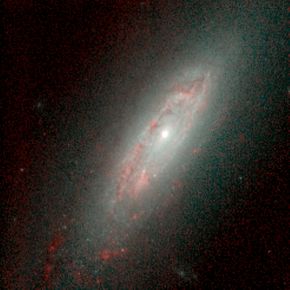
An elliptical galaxy is a type of galaxy with an approximately ellipsoidal shape and a smooth, nearly featureless image. They are one of the four main classes of galaxy described by Edwin Hubble in his Hubble sequence and 1936 work The Realm of the Nebulae, along with spiral and lenticular galaxies. Elliptical (E) galaxies are, together with lenticular galaxies (S0) with their large-scale disks, and ES galaxies with their intermediate scale disks, a subset of the "early-type" galaxy population.

Messier 59 or M59, also known as NGC 4621, is an elliptical galaxy in the equatorial constellation of Virgo. It is a member of the Virgo Cluster, with the nearest fellow member 8′ away and around 5 magnitudes fainter. The nearest cluster member of comparable brightness is the lenticular galaxy NGC 4638, which is around 17′ away. It and the angularly nearby elliptical galaxy Messier 60 were both discovered by Johann Gottfried Koehler in April 1779 when observing comet seeming close by. Charles Messier listed both in the Messier Catalogue about three days after Koehler's discovery.

NGC 1316 is a lenticular galaxy about 60 million light-years away in the constellation Fornax. It is a radio galaxy and at 1400 MHz is the fourth-brightest radio source in the sky.

NGC 4526 is a lenticular galaxy with an embedded dusty disc, located approximately 55 million light-years from the Solar System in the Virgo constellation and discovered on 13 April 1784 by William Herschel.
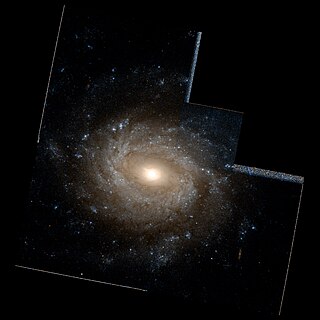
NGC 3486 is an intermediate barred spiral galaxy located about 27.4 million light years away in the constellation of Leo Minor. It has a morphological classification of SAB(r)c, which indicates it is a weakly barred spiral with an inner ring and loosely wound arms. This is a borderline, low-luminosity Seyfert galaxy with an active nucleus. However, no radio or X-ray emission has been detected from the core, and it may only have a small supermassive black hole with less than a million times the mass of the Sun.

NGC 5548 is a Type I Seyfert galaxy with a bright, active nucleus. This activity is caused by matter flowing onto a 65 million solar mass (M☉) supermassive black hole at the core. Morphologically, this is an unbarred lenticular galaxy with tightly-wound spiral arms, while shell and tidal tail features suggest that it has undergone a cosmologically-recent merger or interaction event. NGC 5548 is approximately 245 million light years away and appears in the constellation Boötes. The apparent visual magnitude of NGC 5548 is approximately 13.3 in the V band.

NGC 2859 is a barred lenticular galaxy located some 83 million light years away in the constellation Leo Minor. The morphological classification is (R)SB(r)0+, where the S0+ notation indicates a well-defined physical structure that is lacking in visible spiral arms. It has a strong bar (B) of the "ansae" type, which means it grows brighter or wider toward the tips. A faint, secondary bar is positioned at nearly a right angle to the main bar. These features are surrounded by a weak inner ring (r) that appears diffuse. The outer region of the galaxy hosts a prominent, detached ring (R) that includes a series of blue-hued knots along the eastern side.
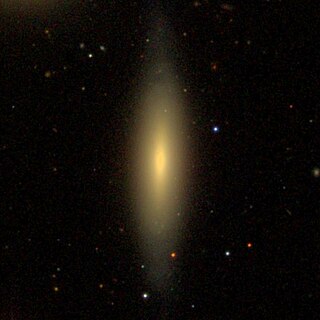
NGC 4550 is a barred lenticular galaxy located in the constellation of Virgo that can be seen with amateur telescopes. It lies at a distance of 50 million light-years from the Milky Way and is a member of the Virgo Cluster.

NGC 4102 is an intermediate barred spiral galaxy located in the northern constellation of Ursa Major. It is visible in a small telescope and has an apparent visual magnitude of 11.2. The galaxy was discovered April 12, 1789 by William Herschel. J. L. E. Dreyer described it as "bright, pretty small, round, brighter middle and bright nucleus". This galaxy is located at a distance of 60 million light years and is receding with a heliocentric radial velocity of 837 km/s. It is a member of the Ursa Major group of galaxies.

NGC 2748 is a spiral galaxy in the northern circumpolar constellation of Camelopardalis, located at a distance of 61.3 megalight-years from the Milky Way. It was discovered September 2, 1828 by John Herschel. The morphological classification of SAbc indicates this is an unbarred spiral with moderate to loosely-wound spiral arms. It is a disk-like peculiar galaxy with a stellar shell that is rotating about the main galactic axis. This shell was most likely formed through the capture and disruption of a dwarf companion. The galactic nucleus likely contains a supermassive black hole with a mass of 4.4+3.5
−3.6×107 M☉, or 44 million times the mass of the Sun.
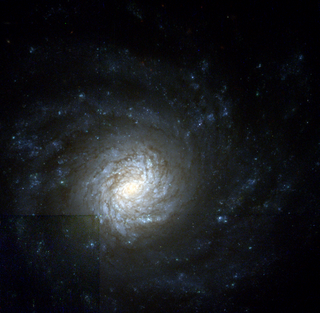
NGC 4041 is the New General Catalogue identifier for a spiral galaxy in the northern circumpolar constellation of Ursa Major. It is located an estimated 70 million light years from the Sun. The morphological classification of SA(rs)bc indicates this is a spiral galaxy the lacks a bar; the 'rs' means it has a weakly-formed ring structure, and the 'bc' indicates the spiral arms are moderately to loosely wound.

NGC 4293 is a lenticular galaxy in the northern constellation of Coma Berenices. It was discovered by English astronomer William Herschel on March 14, 1784, who described it as "large, extended, resolvable, 6 or 7′ long". This galaxy is positioned to the north-northwest of the star 11 Comae Berenices and is a member of the Virgo Cluster of galaxies. It is assumed to lie at the same distance as the Virgo Cluster itself: around 54 million light years away. The galaxy spans an apparent area of 5.3 × 3.1 arc minutes.

NGC 4138 is the New General Catalogue identifier for a lenticular galaxy in the northern constellation of Canes Venatici. Located around 52 million light years from Earth, it spans some 2.1 × 1.3 arc minutes and has an apparent visual magnitude of 11.3. The morphological classification of NGC 4138 is SA0+(r), indicating it lacks a bar formation and has tightly wound spiral arms with a ring-like structure around the nucleus. It has no nearby companion galaxies.

NGC 3941 is a barred lenticular galaxy located in the constellation Ursa Major. It is located at a distance of circa 40 million light years from Earth, which, given its apparent dimensions, means that NGC 3941 is about 40,000 light years across. It was discovered by William Herschel in 1787.
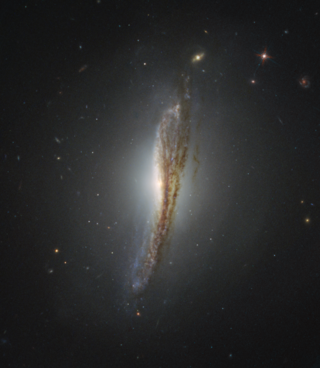
NGC 612 is a lenticular galaxy in the constellation of Sculptor located approximately 388 million light-years from Earth. It is a type II Seyfert galaxy and thus has an active galactic nucleus. NGC 612 has been identified as an extremely rare example of a non-elliptical radio galaxy, hosting one of the nearest powerful FR-II radio sources.

NGC 3489 is a lenticular galaxy located in the constellation Leo. It is located at a distance of about 30 million light years from Earth, which, given its apparent dimensions, means that NGC 3489 is about 30,000 light years across. It was discovered by William Herschel on April 8, 1784. NGC 3489 is a member of the Leo Group.

NGC 1369 is a barred lenticular galaxy located 59 millon light years away in constellation of Eridanus. The galaxy was discovered by astronomer Julius Schmidt on January 19, 1865, and is a member of the Fornax Cluster. NGC 1369 is a host to a supermassive black hole with an estimated mass of 1.8 millon solar masses.
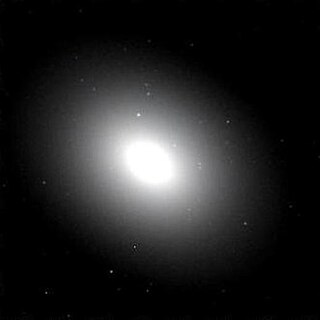
NGC 4365 is an elliptical galaxy located in the constellation Virgo. It was discovered by William Herschel on April 13, 1784.

NGC 4324 is a lenticular galaxy located about 85 million light-years away in the constellation Virgo. It was discovered by astronomer Heinrich d'Arrest on March 4, 1862. NGC 4324 has a stellar mass of 5.62 × 1010M☉, and a baryonic mass of 5.88 × 1010M☉. The galaxy's total mass is around 5.25 × 1011M☉. NGC 4324 is notable for having a ring of star formation surrounding its nucleus. It was considered a member of the Virgo II Groups until 1999, when its distance was recalculated and it was placed in the Virgo W Group.

NGC 2617 is a Seyfert galaxy in the equatorial constellation of Hydra. It was discovered on February 12, 1885, by French astronomer Édouard Stephan. In 1888, Danish astronomer J. L. E. Dreyer described it as "extremely faint, very small, 2 very faint stars involved". It is located at an estimated distance of 202 million light years. In the infrared, the galaxy has an angular size of 0.693 by 0.652 arcminutes.
